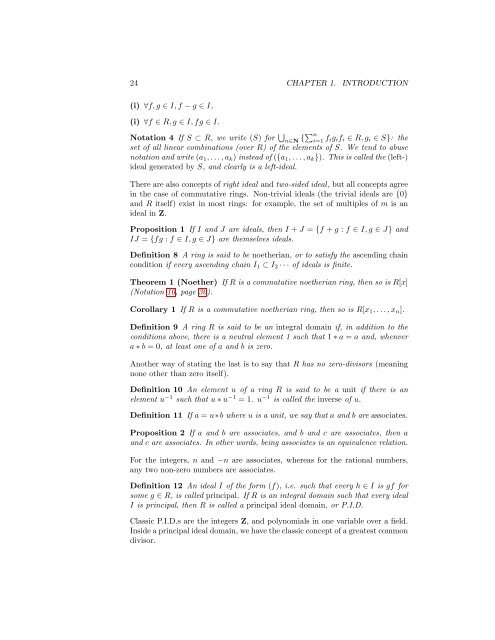Contents - Student subdomain for University of Bath
Contents - Student subdomain for University of Bath
Contents - Student subdomain for University of Bath
Create successful ePaper yourself
Turn your PDF publications into a flip-book with our unique Google optimized e-Paper software.
24 CHAPTER 1. INTRODUCTION<br />
(i) ∀f, g ∈ I, f − g ∈ I,<br />
(i) ∀f ∈ R, g ∈ I, fg ∈ I.<br />
Notation 4 If S ⊂ R, we write (S) <strong>for</strong> ⋃ n∈N {∑ n<br />
i=1 f ig i f i ∈ R, g i ∈ S}: the<br />
set <strong>of</strong> all linear combinations (over R) <strong>of</strong> the elements <strong>of</strong> S. We tend to abuse<br />
notation and write (a 1 , . . . , a k ) instead <strong>of</strong> ({a 1 , . . . , a k }). This is called the (left-)<br />
ideal generated by S, and clearly is a left-ideal.<br />
There are also concepts <strong>of</strong> right ideal and two-sided ideal, but all concepts agree<br />
in the case <strong>of</strong> commutative rings. Non-trivial ideals (the trivial ideals are {0}<br />
and R itself) exist in most rings: <strong>for</strong> example, the set <strong>of</strong> multiples <strong>of</strong> m is an<br />
ideal in Z.<br />
Proposition 1 If I and J are ideals, then I + J = {f + g : f ∈ I, g ∈ J} and<br />
IJ = {fg : f ∈ I, g ∈ J} are themselves ideals.<br />
Definition 8 A ring is said to be noetherian, or to satisfy the ascending chain<br />
condition if every ascending chain I 1 ⊂ I 2 · · · <strong>of</strong> ideals is finite.<br />
Theorem 1 (Noether) If R is a commutative noetherian ring, then so is R[x]<br />
(Notation 10, page 30).<br />
Corollary 1 If R is a commutative noetherian ring, then so is R[x 1 , . . . , x n ].<br />
Definition 9 A ring R is said to be an integral domain if, in addition to the<br />
conditions above, there is a neutral element 1 such that 1 ∗ a = a and, whenver<br />
a ∗ b = 0, at least one <strong>of</strong> a and b is zero.<br />
Another way <strong>of</strong> stating the last is to say that R has no zero-divisors (meaning<br />
none other than zero itself).<br />
Definition 10 An element u <strong>of</strong> a ring R is said to be a unit if there is an<br />
element u −1 such that u ∗ u −1 = 1. u −1 is called the inverse <strong>of</strong> u.<br />
Definition 11 If a = u∗b where u is a unit, we say that a and b are associates.<br />
Proposition 2 If a and b are associates, and b and c are associates, then a<br />
and c are associates. In other words, being associates is an equivalence relation.<br />
For the integers, n and −n are associates, whereas <strong>for</strong> the rational numbers,<br />
any two non-zero numbers are associates.<br />
Definition 12 An ideal I <strong>of</strong> the <strong>for</strong>m (f), i.e. such that every h ∈ I is gf <strong>for</strong><br />
some g ∈ R, is called principal. If R is an integral domain such that every ideal<br />
I is principal, then R is called a principal ideal domain, or P.I.D.<br />
Classic P.I.D.s are the integers Z, and polynomials in one variable over a field.<br />
Inside a principal ideal domain, we have the classic concept <strong>of</strong> a greatest common<br />
divisor.












![[Luyben] Process Mod.. - Student subdomain for University of Bath](https://img.yumpu.com/26471077/1/171x260/luyben-process-mod-student-subdomain-for-university-of-bath.jpg?quality=85)



